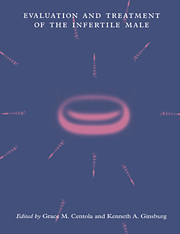Book contents
- Frontmatter
- Contents
- Preface
- List of contributors
- 1 Andrology
- 2 Sperm–egg interaction
- 3 Routine semen analysis
- 4 Computer-aided sperm analysis: a critical review
- 5 Antisperm antibodies: diagnosis and treatment
- 6 The sperm penetration assay
- 7 Intrauterine insemination for male factor
- 8 Processing human semen for insemination: comparison of methods
- 9 New assays for evaluating sperm function
- 10 Assisted reproductive technology for male factor infertility
- 11 Microinjection techniques for male infertility
- 12 Therapeutic donor insemination: screening, indications and technique
- 13 Endocrine assessment and hormone treatment of the infertile male
- 14 The urologic evaluation of the infertile male
- 15 Azoospermia: the diagnosis and treatment
- 16 White blood cells in semen and their impact on fertility
- 17 Psychological aspects of male infertility: lifting the shroud of shame
- 18 Evaluation of the female partner
- Index
2 - Sperm–egg interaction
Published online by Cambridge University Press: 16 September 2009
- Frontmatter
- Contents
- Preface
- List of contributors
- 1 Andrology
- 2 Sperm–egg interaction
- 3 Routine semen analysis
- 4 Computer-aided sperm analysis: a critical review
- 5 Antisperm antibodies: diagnosis and treatment
- 6 The sperm penetration assay
- 7 Intrauterine insemination for male factor
- 8 Processing human semen for insemination: comparison of methods
- 9 New assays for evaluating sperm function
- 10 Assisted reproductive technology for male factor infertility
- 11 Microinjection techniques for male infertility
- 12 Therapeutic donor insemination: screening, indications and technique
- 13 Endocrine assessment and hormone treatment of the infertile male
- 14 The urologic evaluation of the infertile male
- 15 Azoospermia: the diagnosis and treatment
- 16 White blood cells in semen and their impact on fertility
- 17 Psychological aspects of male infertility: lifting the shroud of shame
- 18 Evaluation of the female partner
- Index
Summary
Introduction
This chapter presents an overview of the cell–cell interactions at fertilization, designed to provide a context for the chapters that follow which address the diagnostic and therapeutic procedures employed in the treatment of male infertility. The many original literature citations augmented with recent references, especially to human studies, should be helpful to the reader interested in a more detailed or specific understanding of the underlying physiology and biochemistry (see Dunbar & O'Rand, 1991; and reviews by Yanagamachi, 1988; Saling, 1991; and Green, 1993).
The players and their transport
A discussion of sperm–egg interaction per se would not be appropriate without a few comments to set the stage. Successful fertilization is dependent upon the timely presence of mature gametes in the ampullary oviduct, the normal site of fertilization.
In general terms, the production of fertile sperm requires the concerted activity of the male genital tract with contributions from the testis, epididymis and accessory glands. At the testicular level, spermatogenesis, modulated by endocrine/autocrine/paracrine processes that require approximately 74 days in man, results in the production of and release to the epididymis of large numbers of differentiated sperm cells on a relatively consistent basis. Gamete production in the adult male is continuous, rather than cyclical as in the female. Spermatogenesis and its regulation are complex and poorly understood, and may be influenced by such unrelated parameters as age, scrotal temperature, diet, exercise, stress, smoking, the use of cytotoxic or recreational drugs, toxicant exposure and viral infection.
- Type
- Chapter
- Information
- Evaluation and Treatment of the Infertile Male , pp. 6 - 18Publisher: Cambridge University PressPrint publication year: 1996
- 2
- Cited by



